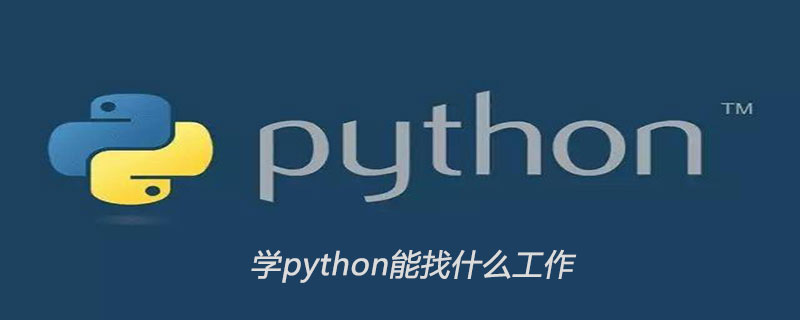

Python positions
What are the Python positions? The main positions are as follows:
Python full stack development engineer ( 10k-20K)
Python operation and maintenance development engineer (15k-20K)
Python senior development engineer (15k-30K)
Python big data engineer (15K-30K)
Python Machine Learning Engineer (15k-30K)
Python Architect (20k-40k)
What Python can do is an interesting question.
What everyone from entry-level players to professional players are doing - crawlers
There are a lot of tutorials on writing crawlers in Python online, as far as I know Many people who are new to Python use it to write crawler programs. It can be as small as crawling a pornographic website, or as large as a commercial application of an Internet company. Getting started with crawlers through Python is relatively simple and easy to learn. You don’t need to master too much basic and low-level knowledge at the beginning. You can get started quickly, and you can produce results quickly. It is very suitable for beginners who want to make something visible at the beginning. A sense of accomplishment in something.
In addition to getting started, crawlers are also widely used in some companies, platforms and organizations that need data. It is a very common practice to achieve some business value by crawling public data on the Internet. Of course, the crawlers of these players are much more powerful and need to deal with many issues including routing, storage, distributed computing, etc. The complexity is many times different from Xiaobai's pornographic capture app.
Web Program
In addition to crawlers, Python is also widely used in Web-side programs. For example, the Zhihu you are using now, the backend of the main website is the tornado framework based on Python , Douban’s backend is also based on Python. In addition to tornado (Tornado Web Server), commonly used web frameworks in Python include Flask (Welcome | Flask (A Python Microframework)), Django (The Web framework for perfectionists with deadlines), etc. Through the above framework, you can easily implement a Web program. For example, some friends I know have written their own blog programs through Python, including the previous zhihu.photo. I implemented the backend through Flask (due to copyright, etc. Because of this, I have stopped this website). In addition to the above frameworks, you can also try to implement a web framework yourself.
Desktop program
Python also has many UI libraries, you can easily complete a GUI program (by the way, when I first came into contact with programming, I thought it was good to write GUI Cool, but it took me a long time to create a small program in VC6, and then I worked in Delphi, Java, etc., and when I finally came into contact with Python, I was no longer interested in GUI). There are many examples of Python implementing GUI, including the famous Dropbox, which is a server-side and client-side program implemented in Python.
Artificial Intelligence (AI) and Machine Learning
Artificial intelligence is a very hot direction now, and the AI boom makes the future of the Python language full of unlimited potential. Most of the several very influential AI frameworks released now are implemented in Python. Why? Because Python is dynamic enough and has sufficient performance, which are the technical characteristics required by AI technology. For example, some websites based on Python-based deep learning libraries, deep learning directions, machine learning directions, and natural language processing directions are basically implemented through Python.
Machine learning, especially the now popular deep learning, most of its tool frameworks provide Python interfaces. Python has always had a good reputation in the field of scientific computing. Its concise and clear syntax and rich computing tools are deeply loved by developers in this field.
Long before deep learning and Tensorflow and other frameworks became popular, scikit-learn existed in Python, which can easily complete almost all machine learning models. It only takes a few simple lines to download classic data sets and build models. code. It can be easily adjusted with tools such as Pandas and matplotlib.
Deep learning frameworks such as Tensorflow, PyTorch, MXNet, and Keras have greatly expanded the possibilities of machine learning. Using Keras to write a deep learning network for handwritten digit recognition only requires a few dozen lines of code, and you can use the underlying implementation to easily call a large number of resources, including GPUs, to complete the work.
It is worth mentioning that no matter what framework, Python is only used as a language for front-end description, and the actual calculation is implemented through the underlying C/C. Because Python can easily introduce and use C/C projects and libraries to achieve expansion in functionality and performance, in such large-scale calculations, developers can focus more on the logic of the data itself, and focus less on complex work such as memory allocation. Liberation is an important reason why Python is widely used in the field of machine learning.
Scientific Computing
Python’s development efficiency is very high, and modules with higher performance requirements can be rewritten in C and called by Python. At the same time, Python can solve higher-level abstract problems, so it is also very popular in the field of scientific computing. The emergence of third-party libraries for scientific computing, including scipy and numpy, is even more convenient for those who have a certain mathematical foundation but have average computer skills.
The above is the detailed content of What kind of job can you get by learning python?. For more information, please follow other related articles on the PHP Chinese website!